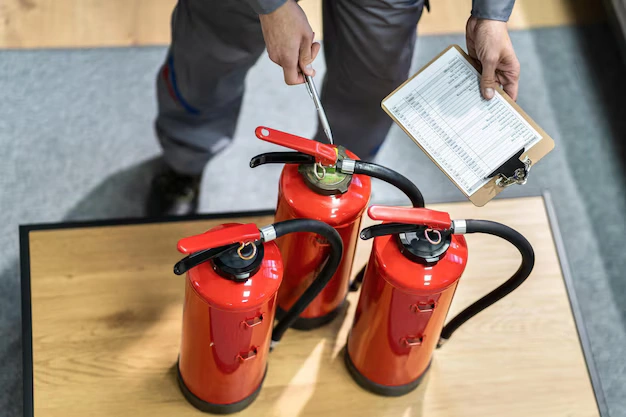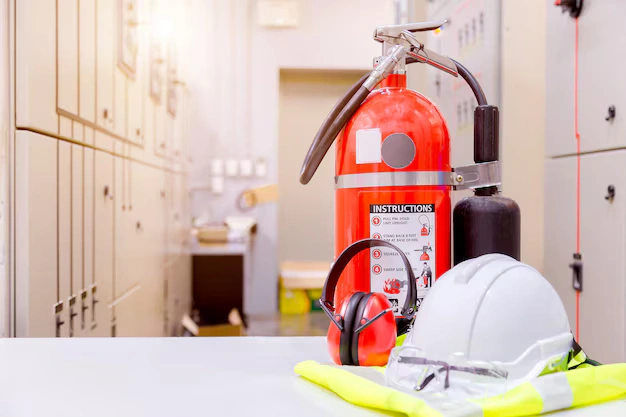In the modern workplace today, fire safety is an even more important consideration than it ever was. As we rely more on electronic devices, complex machinery, and open office spaces, the risk of fire hazards is changing. The workplaces should be provided with suitable detection and prevention systems to limit the risk of fires for the protection of employees, properties, and assets. Fire safety basics are crucial knowledge about what fire hazards reduce and keep your workplace safe.
In this article, we shall go through the fire safety essentials every modern workplace must have, from fire prevention strategies to the correct fire safety equipment and employee training.

1. Fire Prevention: Reducing the Risk
Fire prevention serves as the most important aspect of fire safety. It is much better to prevent a fire before it ever starts than to have to respond to one once it does. Some key fire prevention measures include:
Electrical Safety
A leading cause of workplace fires is electrical equipment. Fires can also be ignited by faulty wiring, overloaded circuits, or damaged power cords.
Key actions for electrical safety:
Check electrical equipment at regular intervals to ensure that it is operating correctly.
Then, avoid overloading power outlets and power strips. Connect only what is absolutely necessary.
Make sure workers are informed about the dangers of electrical devices like frayed cords or poorly grounded equipment.
Schedule regular maintenance for all electrical systems and have any repairs or upgrades carried out by a licensed electrician.
Flammable Materials Handling
Most offices maintain flammable items, like cleaning products, paper goods, or chemicals. These materials can ignite easily if not properly handled or stored.
Key actions for handling flammable materials:
Store chemicals and flammable liquids in fireproof cabinets or containers.
Put labels on the materials, so you know how to store and handle them properly.
Fire Safety Equipment Maintenance
Fire safety equipment (extinguishers and alarms, for example) must be regularly tested and maintained to make sure it’s functioning properly.
Key actions for equipment maintenance:
And make sure to install smoke detectors and fire alarms in strategic locations, including hallways and common rooms.
Test fire alarms every month, and replace the batteries in smoke detectors at least annually.
Make sure fire extinguishers are reachable, functional, and serviced in the past year.
Maintain and inspect all sprinkler systems according to local fire code.
Proper Storage and Organization
Clutter in a workspace also creates a fire hazard by blocking escape routes and fuelling fires. Proper storage and organization can help reduce fire spread.
Key actions for organization:
Leave hallways and escape routes free of obstructions. There should be an obvious route for employees to exit in case of an emergency.
Never pile materials near heat sources or electrical outlets.
Train your staff to carry out regular waste disposal as per waste disposal systems.
Fire Detection: Early Warning Systems
In the event of a fire, early detection is the best way to minimize damage and ensure safe evacuation. Early warnings can only be achieved when modern workplaces are equipped with the right fire detection systems.
Smoke Detectors and Fire Alarms
Smoke detectors & fire alarms are our first line of defence against fire & one of the most important early warning devices for fire.
Key actions for smoke detection:
Make sure you install smoke detectors around the office, including areas where the chances of a fire are higher (kitchen, storage rooms, etc.).
Check smoke detectors monthly and change batteries when needed.
Alarms should be loud enough to be heard throughout the building, including basements or large open areas.
This means having your alarms integrated with your evacuation systems so that when an alarm goes off, employees know which way to evacuate.
Heat Detectors
Smoke detectors are not the best option in some environments. Heat detectors are best suited for places where minimal smoke may be present, but heat could rise quickly, such as kitchens or server rooms

Key actions for heat detection
Where smoke or fumes are minimal, but heat build-up is a concern, install heat detectors in high-risk areas.
Make sure heat detectors are installed at the correct height and in a location away from vents or drafts.
Smart Fire Safety Systems
As technology evolves, so do fire safety systems. An increasing number of modern workplaces are relying on smart fire safety systems that integrate with building management systems.
Key actions for smart systems:
Use connected fire alarm systems that can alert management or security personnel remotely.
Have smart smoke detectors that send alerts directly to employees’ phones, or link to other systems (e.g., HVAC systems) to limit the spread of smoke or fire.
Have fire detection systems interface with the emergency lighting and evacuation systems to provide an automated, coordinated response.
Fire Safety Equipment: Essential Tools
This is why it is extremely important to have the right fire safety equipment in place in any workplace. In case of a fire emergency, employees must be trained on how to operate the equipment.
Fire Extinguisher
Fire extinguishers are essential tools that can put out smaller fires before they become a huge problem. There are different extinguishers for different forms of fire, and as such it is important that you choose the right type for your work place.
Key actions for fire extinguishers:
Show workers how to use a fire extinguisher. They need to know about the PASS (Pull, Aim, Squeeze, Sweep) method.
Check fire extinguishers regularly to see that they are charged and operational.
Fire Blankets
Fire blankets can help put out small flames like wax (kitchen) or flammable liquids.
Key actions for fire blankets:
Place fire blankets near kitchen areas or places where small fires are prone to happen.
The most important is to train the employees on the use of fire blankets for extinguishing small fires, especially grease fires.
Emergency Lighting
Fires can hinder surrounding residents from leaving; power outages during such events make evacuating challenging. Emergency lighting enables employees to find their path to safety, even in darkened or smoke-obscured conditions.

Key actions for emergency lighting:
Install emergency lighting along escape routes and near exits.
Make sure that the lighting connects to the emergency power source that activates during a power outage.
Regularly test emergency lighting to confirm it is working in a power outage.
Conclusion
Fire safety cannot work if it is left completely to your employer. A safer workplace can be achieved through the installation of fire-detection systems, regular maintenance of safety equipment, and extensive employee training. In today’s modern office style, fire safety needs to be an active and ongoing process with everyone in the team taking an active role in achieving the best safety standards.
These fire safety essentials will not only help to reduce the likelihood of fires but will also protect your employees and help to ensure your business keeps on running. So, what are you waiting for? Take your workplace emergency prevention strategies now before it is too late!
FAQs
1.Key actions for emergency lighting:
Evacuate the building immediately through the nearest safe exit, and do not take elevators. Call emergency services and do not go back inside the building until it is safe to do so.
2. How do I choose the right fire extinguisher for my office?
Think about the kinds of materials and hazards in your work environment. A Class ABC fire extinguisher is generally ideal for most office settings, as these can be used for fires that include ordinary combustibles, flammable liquids, and electrical equipment.
3. Are fire sprinklers required in all workplaces?
Many work environments, including big buildings, require fire sprinkler systems, for example. Consult local fire codes and regulations to find out what is specifically required of your office.
4. Can fire safety equipment be used without training?
Although most fire protection equipment is easy to use, staff need to be trained so they know how to use it safely and effectively in an emergency.


